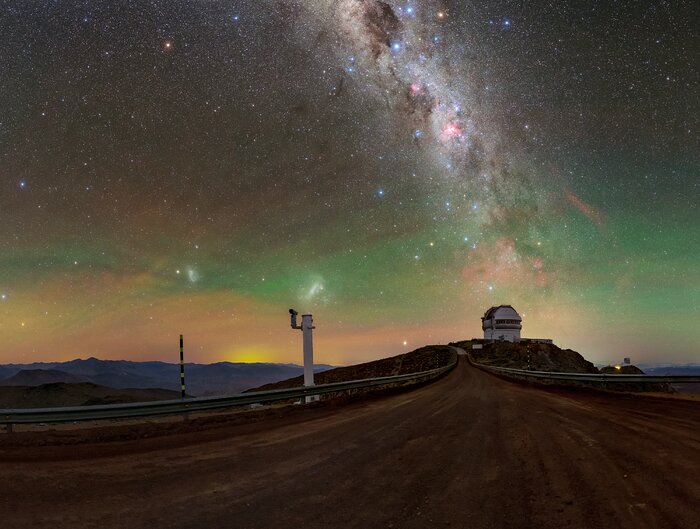Dark Skies Aren’t Always Black Skies
Paradoxically, a truly dark sky isn’t pitch black. The darkest skies in the world, such as this one over Cerro Pachón, are actually theaters for a spectacular show of cosmic lights. Above Gemini South (right of center), half of the International Gemini Observatory operated by NSF’s NOIRLab, and Vera C. Rubin Observatory (right), a Program of NSF’s NOIRLab, the lights from stars, our galaxy, and atmospheric interplay are captured with a long exposure in this Image of the Week.
Near the horizon is a hazy sea of faint red and green light known as airglow; this glow is caused by atomic processes in the Earth’s atmosphere. Our neighboring galaxies, the Small and Large Magellanic Clouds, are visible as blobs of light above the striped pole and the white post, respectively.
Above Gemini South is the blooming Gum Nebula, the remains of a supernova whose red color is due to its abundance of hydrogen. Of course our home galaxy, the Milky Way, is impossible to ignore in this image. The remote Chilean sky brings out its bright disk and dark molecular clouds.
Even in this dark night, urban illumination looms. On the other side of the horizon between the pole and the post is light from a nearby town. Light pollution can pose a threat to all these light shows, so NOIRLab is working to protect our dark skies.
This photo was taken as part of the NOIRLab 2022 Photo Expedition to all the NOIRLab sites. Tomáš Slovinský, the photographer, is a NOIRLab Audiovisual Ambassador.
Credit:International Gemini Observatory/NOIRLab/NSF/AURA/T. Slovinský
About the Image
| Id: | iotw2409a |
| Type: | Photographic |
| Release date: | Feb. 28, 2024, noon |
| Size: | 6107 x 4614 px |
About the Object
| Name: | Gemini South |
| Category: | Gemini Observatory |
